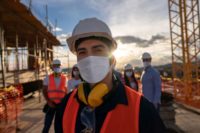OSHA details most commonly-cited COVID-19 violations

The Occupational Safety and Health Administration (OSHA) recently issued guidance and an accompanying one-page summary outlining which standards are most frequently cited during coronavirus-related inspections. OSHA based these documents on data gleaned from citations issued as the result of complaints, referrals, and fatalities related to COVID-19. According to OSHA, most of these citations were issued to industries such as hospitals and healthcare, nursing homes and long-term care facilities, and meat/poultry processing plants. However, all employers should take note in order to avoid similar pitfalls.
Key points
The guidance makes it clear that the most commonly cited standards related to COVID-19 involve respiratory protection and personal protective equipment (PPE). Based on the data provided by OSHA, it is evident that many employers are issuing respirators to employees without the required medical evaluation and without establishing and implementing a written respiratory protection program.
Carefully review OSHA’s Respiratory Protection standard to ensure that you are complying with each requirement, from fitment to training.
OSHA’s guidance also highlights the importance of reviewing OSHA’s Personal Protective Equipment standard. You should ensure that you have assessed your workplace to determine if COVID-19 hazards are present which will require the use of PPE. If additional PPE is required, you should properly train workers to safely use all new PPE.
You should continue to keep the required records of all work-related fatalities, injuries, and illnesses. OSHA’s existing injury and illness recording and reporting requirements do apply to COVID-19, if the case is a confirmed case of COVID-19 and is work-related. For any fatality that occurs within 30 days of a work-related incident, the fatality must be reported to OSHA within eight hours of the employer becoming aware of the fatality. For a work-related incident resulting in an employee being hospitalized, the hospitalization must be reported to OSHA within 24 hours of the employer becoming aware of the hospitalization.
The one page document titled "Lessons Learned: Frequently Cited Standards Related to COVID-19 Inspections," and accompanying guidance document provide available resources that address the most frequently cited standards, including Respiratory Protection, Recording and Reporting Occupational Injuries and Illnesses, Personal Protective Equipment and the General Duty Clause. The Lessons Learned document provides examples of requirements employers must follow, such as:
- Provide a medical evaluation before a worker is fit-tested or uses a respirator.
- Establish, implement, and update a written respiratory protection program with required worksite-specific procedures.
- Train workers to safely use respirators and/or other personal protective equipment (PPE) in the workplace, and retrain workers about changes in the workplace that might make previous training obsolete.
- Store respirators and other PPE properly in a way to protect them from damage, contamination, and, where applicable, deformation of the facepiece and exhalation valve.
- Keep required records of work-related fatalities, injuries, and illness.
OSHA is providing the guidance to help employers protect workers and increase compliance with OSHA requirements.
Looking for a reprint of this article?
From high-res PDFs to custom plaques, order your copy today!









.jpg?t=1721257160)